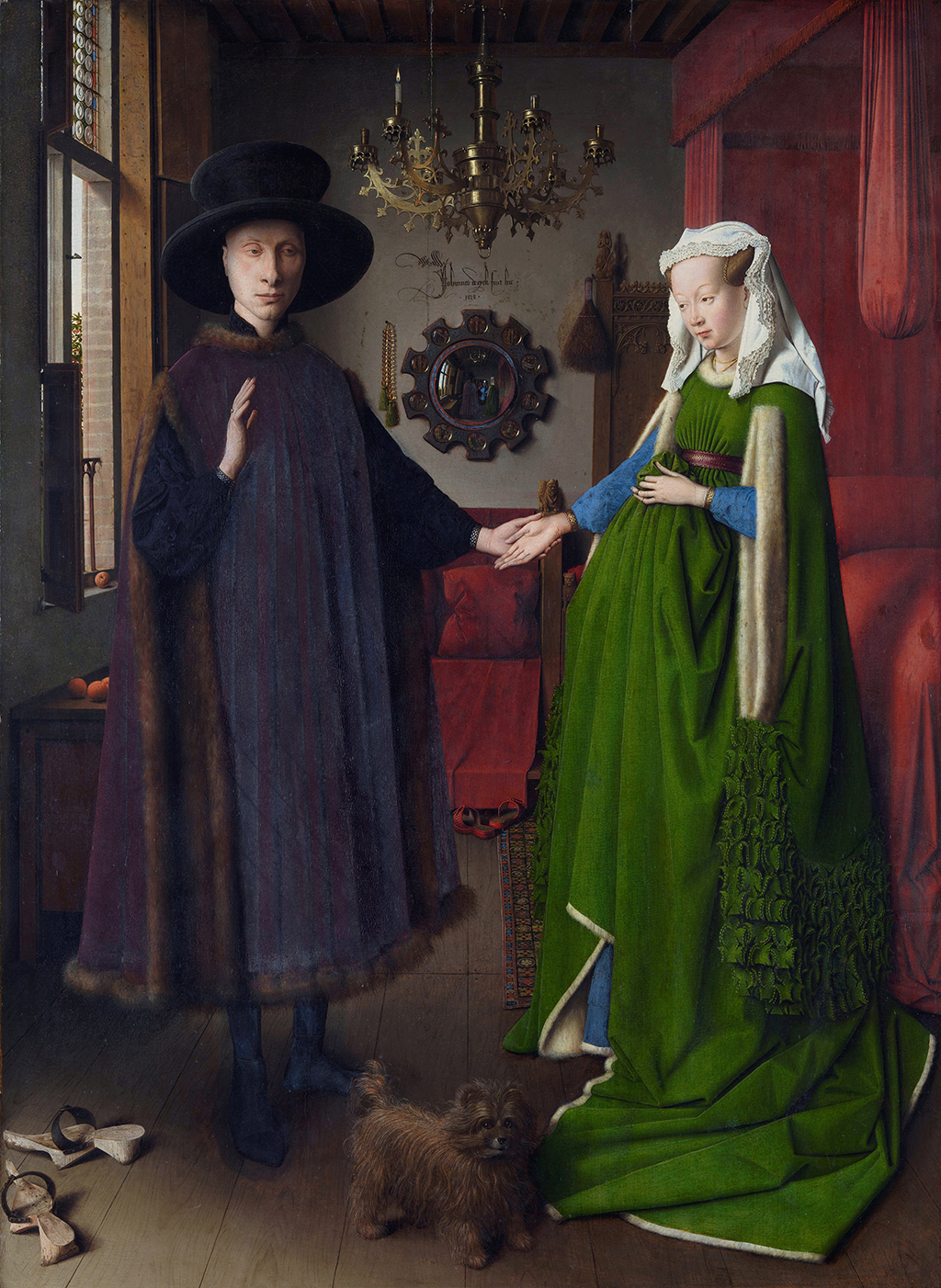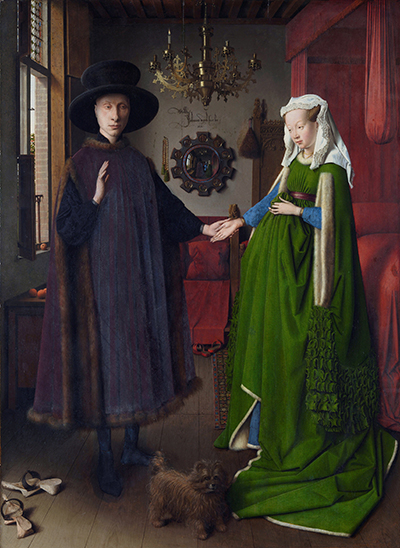Jan van Eyck's The Arnolfini Wedding must surely rank as his most significant contribution to the Northern Renaissance, alongside perhaps the extraordinary Ghent Altarpiece
This famous painting is a portrait of a two members of a merchant family from Lucca who had been living in Bruges, in modern day Belgium. The subjects involved are believed to be Giovanni di Nicolao Arnolfini and his wife at that time. The painting was dated by the artist himself as 1434 as part of his frequently used signature, which playfully translates as 'Jan van Eyck was here'.
One of the most discussed and researched issues of this painting has been in identifying the two subjects of the portrait. Information has come to light as recently as the 1990s which has helped to form the current belief that it was Giovanni di Nicolao Arnolfini in the painting and not his cousin, Giovanni di Arrigo, as had previously been believed.
Once we accept this as true, we then have the challenge of identifying his wife of that period, which is harder than you might expect. If he were to have had a second wife, she remains undocumented, whilst his first wife, Costanza Trenta, died before the painting was produced. Elements in the scene (snuffed candle above her portrait, scenes after Christ's death on her side of the background and the black garb of the man) suggest that this was a memorial piece, therefore, to his first wife who passed away in childbirth a year before.
Giovanni di Nicolao Arnolfini would later appear again in another Jan van Eyck portrait, this time on his own. Perhaps he was friends with the artist, as Jan van Eyck rarely painted the same person more than once. The double portrait was also a very personal item in terms of content, if the current theories are true, and that may have helped strengthen their bond of friendship.
This masterpiece from 1434 measures 62.5cm wide by 84.5cm tall. It was produced in oil on oak panel, with Jan van Eyck being one of the very first artists to have used oils, when previously egg tempera had been used in European art. Indeed it was the influence of artists from the Flemish region who influenced the Italian artists to make the change to oils.
Upon first glance this painting will appear fairly simple, a touching portrait within a domestic setting. In fact there is a complex network of elements to appreciate here, making this such an impressive work. There is Van Eyck's typical use of iconography, a relatively new idea at this stage in art history, plus also an ingenious use of a mirror which serves as a painting within a painting.
Whilst Van Eyck's use of oils was revolutionary, alongside the contributions of his brother, Hubert, it is this particular painting plus their work on the Ghent Altarpiece that remain the oldest examples of oils on panel. Whilst Italian artists had influenced the Flemish painters in their early years, the impact was not starting to be felt in the opposite direction for the first time. The vibrant colours and translucent layers brought about by oil paint would now spread to the Papal States of Italy.
Jan van Eyck's artistic reputation was considerable during his own lifetime and continued consistently throughout the centuries that have passed since. It was as early as 1842 that this painting was purchased by the National Gallery in London, where the work still remains today. We have included a Youtube video below in which the gallery introduce this major artwork. This prestigious work is occassionally loaned out as part of the UK's commitment to exchanging art through prominent exhibitions, so it is always worth checking prior to visiting this venue that this particular work is on display.
That said, this gallery holds amongst the finest permanent collections in the world and those with a broad interest in art will find plenty to excite and inspire. The full list of highlights is too long to mention here but amongst our favourites would have to be the likes of The Fighting Temeraire by William Turner, The Ambassadors by Hans Holbein, Samson and Delilah by Peter Paul Rubens and Mr and Mrs Andrews by Thomas Gainsborough.
The National Gallery has a broad range of art movements within its collection though the artists most closely related to Jan van Eyck who have attributed paintings within this insitution include the likes of Duccio, Paolo Uccello, Filippo Lippi, Andrea Mantegna, Sandro Botticelli, Albrecht Durer, Hans Memling and Giovanni Bellini.
The use of oils brought about advancements in the way in which lighting could be depicted across a canvas. If you compare the work of Jan van Eyck to the early periods of Italian art as it blended from medieval to the Early Renaissance, you will see clear differences between the techniques, tools and styles. Jan van Eyck in The Arnolfini Wedding considers the impact of light on each and every object in the painting - see how the chandelier reflects the light entering from the open window. He then repeats this in the mirror which sits at the back of the scene, only with that composition bent in order to give the impression of its bulbous shape.
The National Gallery has taken exceptional care of the work since purchasing it in 1842, as is the case for most UK-based masterpieces. London itself is large and wealthy enough to support several highly significant national galleries and art museums, ensuring that there has been enough finance to protect their paintings both from criminal acitivities as well as the impact of natural light and climate whilst being placed on display.
The current condition of this oil on panel is therefore very good. There are small areas on the painting where paint has become thin enough to see the wood behind it and there are also a few areas of damage that are fairly typical of paintings that are this old. The original work has been retouched over the centuries but the work of Jan van Eyck is still faithfully preserved.
Sadly, there are no preparatory sketches available on this painting. The typical artistic process used by Van Eyck would have been to produce several study drawings prior to starting on the main commissioned painting but such was the fragility of that medium that very few have survived to the present day.
This article has discussed the detail that is placed by the artist across the composition, be it both in the foreground and background. We have therefore included a larger image of the painting below so that you can appreciate more of iconography, the lighting and the beautiful clothing that adorns both figures. You can even examine the pretty dog at the bottom of the panel painting in closer detail.





